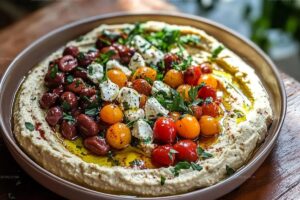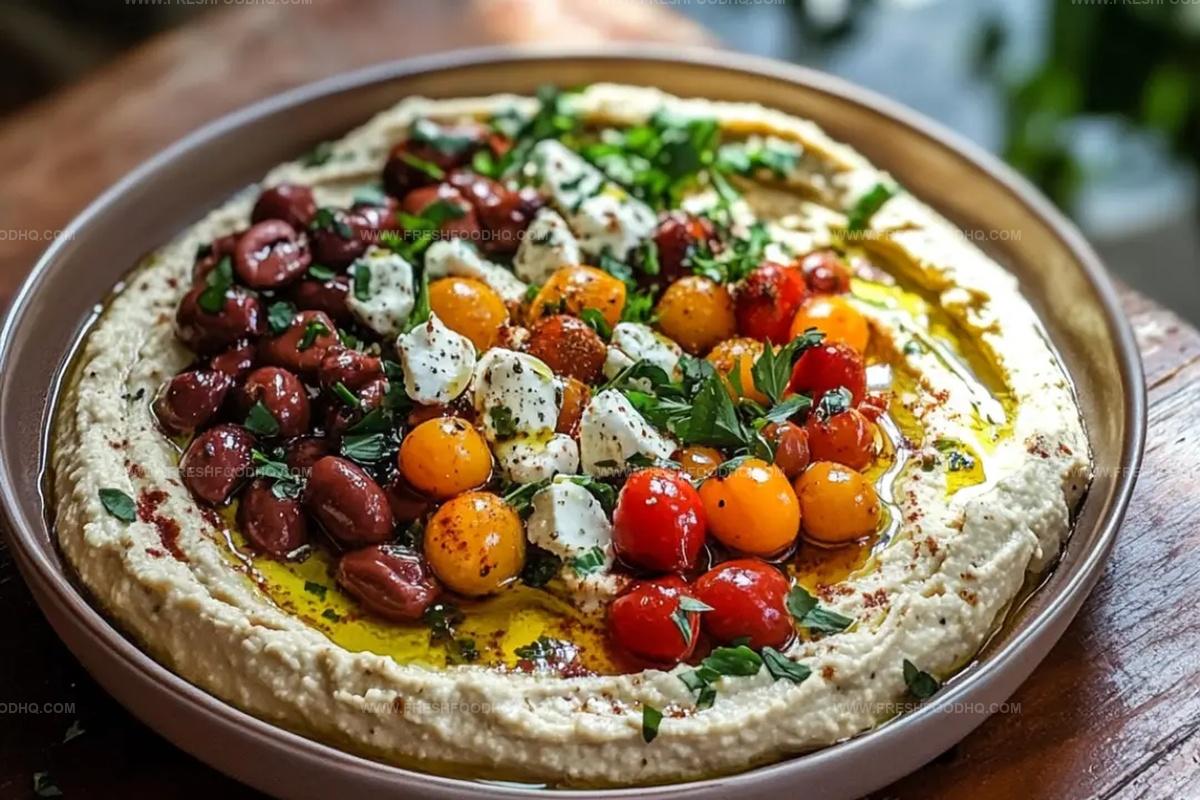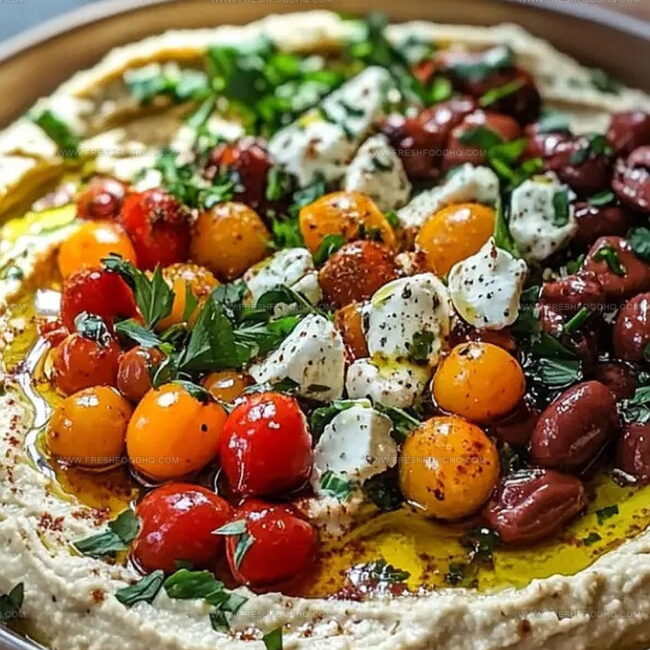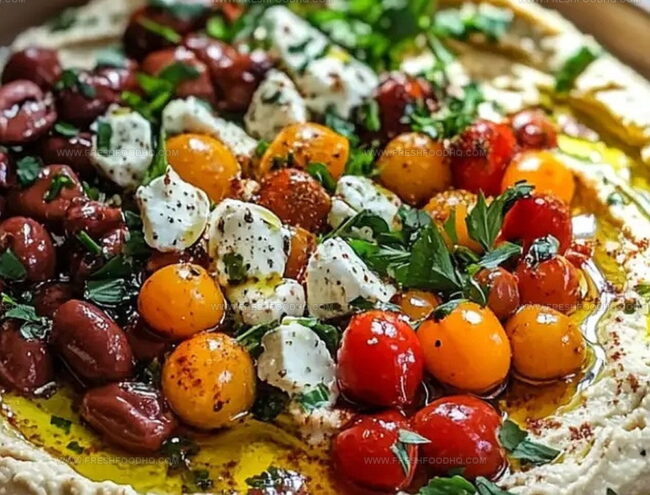Sunny Mediterranean Greek Style Loaded Hummus Recipe
Creamy and vibrant greek style loaded hummus bursts with Mediterranean flavors that dance across your plate.
Smooth chickpea goodness becomes a canvas for colorful toppings that make every bite exciting.
Layers of fresh herbs, tangy feta, and zesty olive oil create a stunning appetizer perfect for sharing.
Crisp vegetables and warm pita bread complement the rich, velvety base of this classic dip.
Juicy cherry tomatoes and fragrant parsley add bright, fresh notes that wake up your taste buds.
Packed with protein and nutrients, this recipe transforms a simple spread into a show-stopping experience.
You won’t be able to resist diving into this delicious creation that brings the sunny Greek islands right to your table.
Why Greek Style Loaded Hummus Is a Flavorful Snack
Ingredients for Greek Style Loaded Hummus
For the Base:For the Veggie Topping:For the Herbs and Seasonings:For the Garnish and Serving:How to Make Greek Style Loaded Hummus at Home
Step 1: Chop Fresh Mediterranean Vegetables
Grab a medium mixing bowl and dice cherry tomatoes, cucumbers, and red onion into small, uniform pieces. Mince fresh garlic and slice olives if you’re using them.
Sprinkle dried oregano over the chopped vegetables and drizzle with extra virgin olive oil. Season generously with salt and black pepper.
Gently toss all ingredients together so the flavors start mingling.
Step 2: Create Smooth Hummus Base
Select a beautiful serving platter or wide shallow bowl.
Spread creamy hummus evenly across the surface, creating a soft, inviting layer that will be the foundation of your dish. Use the back of a spoon to create gentle swirls and peaks for visual texture.
Step 3: Layer Mediterranean Vegetable Medley
Carefully spoon the prepared vegetable mixture over the hummus, distributing the colorful ingredients uniformly. Ensure every section of the hummus gets some veggie love.
Step 4: Add Gourmet Finishing Touches
Enhance the dish with these delightful garnishes:Step 5: Serve and Enjoy
Present the loaded hummus with:Tips for Creamy and Delicious Loaded Hummus
Variations to Personalize Greek Style Loaded Hummus
Pairings That Go Well with Loaded Hummus
How to Store Greek Style Loaded Hummus Fresh
FAQs
This dish is packed with nutrients from vegetables, olive oil, and hummus base. It offers protein, healthy fats, fiber, and various vitamins from fresh ingredients like tomatoes, cucumbers, and herbs.
Yes, this recipe is naturally vegetarian and vegan-friendly. The base ingredients like hummus, vegetables, and herbs are plant-based, making it suitable for multiple dietary preferences.
The recipe captures authentic Greek flavors through ingredients like oregano, olives, red onion, fresh herbs, sumac, and olive oil. These components create a tangy, aromatic Mediterranean taste profile.
Print
Greek Style Loaded Hummus Recipe
- Total Time: 20 minutes
- Yield: 4 1x
Description
Creamy Greek-style loaded hummus elevates classic chickpea dip with Mediterranean flair. Rich Mediterranean ingredients dance across smooth hummus, inviting hungry guests to savor each delectable spoonful.
Ingredients
Main Ingredients:
- 2 cups hummus
- 1.5 cups cherry tomatoes
- 0.5 cups cucumbers
- 0.25 cups kalamata olives
Vegetables and Herbs:
- 1 small red onion
- 2–3 pepperoncini peppers
- 1 clove garlic
- 0.5 tablespoons fresh parsley
- 0.5 tablespoons fresh mint
- 0.5 tablespoons fresh chives
Seasonings and Oils:
- 0.5 teaspoon oregano
- Salt (to taste)
- Pepper (to taste)
- 0.25 cups olive oil
- Sumac (for sprinkling)
Optional Additions:
- Toasted pine nuts
- Lemon slices or wedges
- Paprika (for sprinkling)
Instructions
- Craft a vibrant vegetable medley by combining diced cherry tomatoes, crisp cucumbers, sharp red onion, minced garlic, and optional briny olives in a mixing bowl.
- Enhance the vegetable mixture with aromatic oregano, rich olive oil, and a robust seasoning of salt and pepper, gently incorporating fresh herbs for depth of flavor.
- Select a wide serving platter or shallow dish and create a smooth, even layer of creamy hummus across the surface.
- Delicately distribute the prepared vegetable mixture atop the hummus, ensuring an elegant and even coverage.
- Elevate the presentation by scattering toasted pine nuts, sprinkling sumac or paprika for a complex flavor profile, and adorning with fresh herb leaves for visual appeal.
- Accompany the loaded hummus with zesty lemon wedges to add a bright, citrusy dimension to the dish.
- Serve immediately alongside warm pita bread, crispy pita chips, or an assortment of fresh vegetable crudités for optimal dipping experience.
Notes
- Customize veggie toppings based on seasonal availability to keep the dish fresh and exciting.
- Enhance flavor by marinating vegetables in herbs and olive oil for 15-30 minutes before assembling.
- Opt for homemade hummus for richer, more authentic taste compared to store-bought versions.
- Swap pine nuts with other nuts like almonds or walnuts for dietary preferences or budget-friendly alternatives.
- Prep Time: 20 minutes
- Cook Time: 0 minutes
- Category: Appetizer, Snacks
- Method: Blending
- Cuisine: Mediterranean
Nutrition
- Serving Size: 4
- Calories: 250 kcal
- Sugar: 3 g
- Sodium: 320 mg
- Fat: 18 g
- Saturated Fat: 2.5 g
- Unsaturated Fat: 15 g
- Trans Fat: 0 g
- Carbohydrates: 17 g
- Fiber: 5 g
- Protein: 7 g
- Cholesterol: 0 mg




Ethan Caldwell
Founder & Culinary Innovator
Expertise
Farm-to-table cooking, Seasonal recipe creation, Culinary storytelling, Food photography and styling
Education
The Chef’s Academy (Indianapolis, IN)
Ethan didn’t just fall in love with food, he grew into it, surrounded by fields, farmers’ markets, and family meals that told a story.
After sharpening his skills at The Chef’s Academy, he took his passion straight into the farm-to-table movement, working side-by-side with local growers and seasonal flavors.
He believes every recipe should feel like a walk through a summer market: colorful, fresh, and full of possibility.
Outside the kitchen, Ethan’s idea of a perfect day is hiking mountain trails, digging into heirloom vegetables, and hosting casual dinners where seconds are always encouraged.